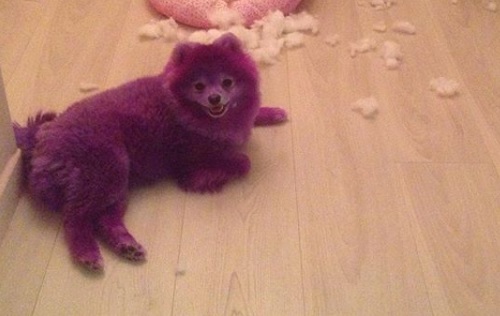Aditya Vaibhav | The TrickyScribe: It is strange how outlandish fashion trends can be very demanding if applied to animals. One latest trend jog trotting in the animal kingdom is dying the fur of pets. Internet, Instagram in particular, is inundated with photos of pink Pomeranians and green Chow-Chows almost resembling a Panda.
View this post on Instagram
CHEMICALS CAUSE ALLERGIES
It is medically proven that there is no dye tested 100 percent safe for animals. Chemicals found in hair colour including hydrogen peroxide and ammonia, are very strong and can cause allergic reactions in pets. Hair colouring is a human fad and pets should be kept away. Not just skin allergies but dyed hair can pose a potential threat to the pet’s overall wellbeing; dogs and cats constantly lick their fur (or coat) and in the process ingest the harmful chemical laden dye. Don’t be fooled by ‘dog-friendly dyes’ by local pet spas and dog-grooming parlours for getting hair streaking done on canines.
READ MORE: UNEP Champions of the Earth award to PM Modi
ADVERSE IMPACT ON HUMANS ALREADY KNOWN
Humans are known to have reported burning sensations and skin irritation upon using even the best of hair dyes. It is therefore important to note that a dog’s skin is much more sensitive as compared to that of humans. Colouring a dog’s hair means that its entire body will have to be exposed to toxic colour. It is also likely that in the course dyes can get into the ears, eyes and even the mouth of the pet. If the dog swallows the chemical dye while licking its coat, it can lead to vomiting, nausea and diarrhoea among other critical sicknesses.
PET TRAUMA
Why subject the dogs to a process that is beyond their comprehension? Human beings like to experiment with their looks and adopt various cosmetic procedures such as hair-dying to increase their aesthetic appeal. Pets, however, don’t understand this concept of beautifying oneself unnaturally. Exposing pets to such an abnormal procedure means exposing it to psychological trauma.
View this post on Instagram
FROM HORSE’S MOUTH
Veterinarians and animal activists, while blaming social media for the perils of the urban pets, lamented that many present day pet parents are getting their pets coloured. “People copy what they see on Internet. Blindly! Coloured dogs are not rare sighting at pet shows these days. It is absolutely pointless to colour a living organism. In such cases, dogs are kept as mere showpieces, not treated as family members. It’s more about seeking attention for oneself than for the dog. It can lead to health hazards and can also be very stressful for the pet,” said Senior Research Fellow, Department of Zoology, Patna University, Gaurav Narayan.
READ MORE: Uncurbed mining, quarrying behind Kerala Floods

A dog painted in tigerstripes; PICTURE Credit: Avdhesh Chaudhary
DAMAGE TO FUR
“Some want to colour their dogs with food grade or herbal colours. I dissuade them personally that no colour can be cent-percent safe! They may not be harmful for humans but they are yet to be checked on animals and can lead to allergic reactions. They can damage the fur and skin of the pet, and cause serious diseases over the years,” told veterinarian Dr Vijesh Ittyavirah The TrickyScribe.
Internet too throws up bizarre things. Amongst all oddities, a purple dog may not immediately strike you as out of place. If you look up close, however, you’ll realize that the colour is not a result of the efforts of an impeccable pair of hands and Photoshop, it’ll take you to a subsequent question if it is safe.
CORBETT AND AROUND

Artificial flowers spotted along the road between Dhikuli and the national park; PICTURE Credit: Avdhesh Chaudhary
One such dog, but painted for different reasons, came across Delhi-based scribe Avdhesh Chaudhary when he recently accompanied his colleagues to Jim Corbett National Park, a forested wildlife sanctuary in India’s northern state of Uttarakhand rich in flora & fauna and noted for its Bengal tigers. To his astonishment, the dog was painted in tiger stripes. Artificial flowers were spotted on the bushes along the road between Dhikuli and the national park. See photographs. Despite several attempts, local authorities were not available to comment.
The Way Ahead!
Animals cannot voice the discomfort inflicted. That, however, doesn’t validate such an act. Animal enthusiasts across the world are vocally expressing displeasure and spreading awareness on the negatives of dying animal fur; #SpareTheDogCampaign and #PerceivePetsAsNatureIntendedThemToBe enjoy skyrocketing global follower base.
Another issue we’d be taking forward in our upcoming updates is the nexus of fake wildlife derivatives that have flooded the market includes tiger pelts, tusks, made out of Plaster of Paris, and camel teeth, which are palmed off as tiger teeth. Gangs involved reportedly collect hides of dead cows, calves and buffalos and by using chemicals and dyes, transformed them to apparently match that of a tiger. Stay tuned!
Total Views: 2,63,770
